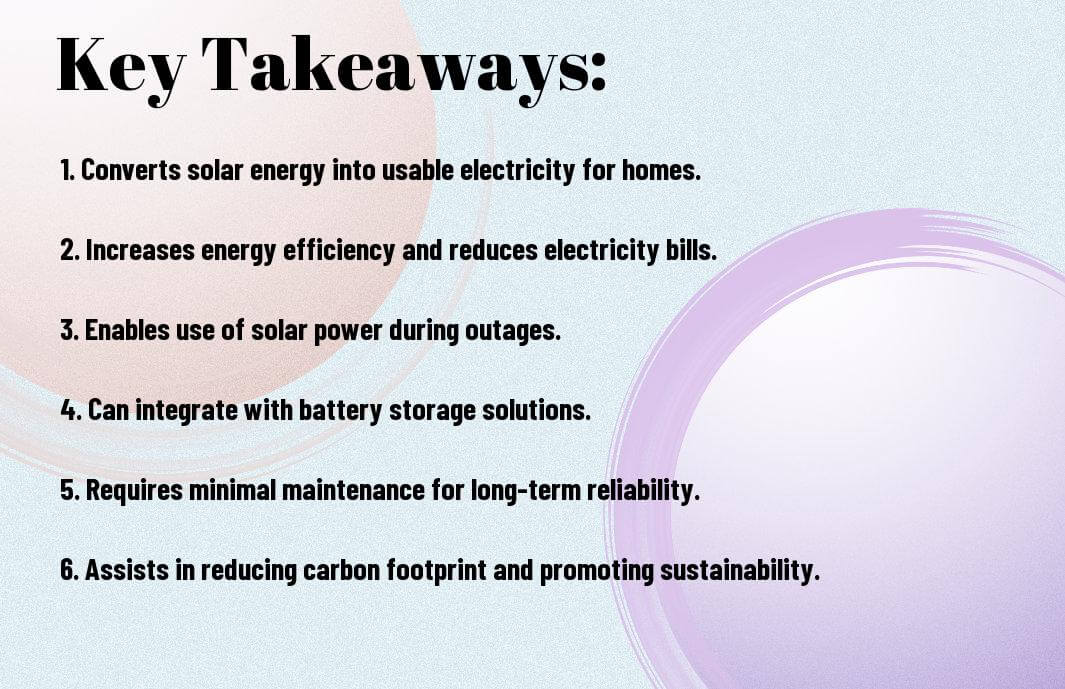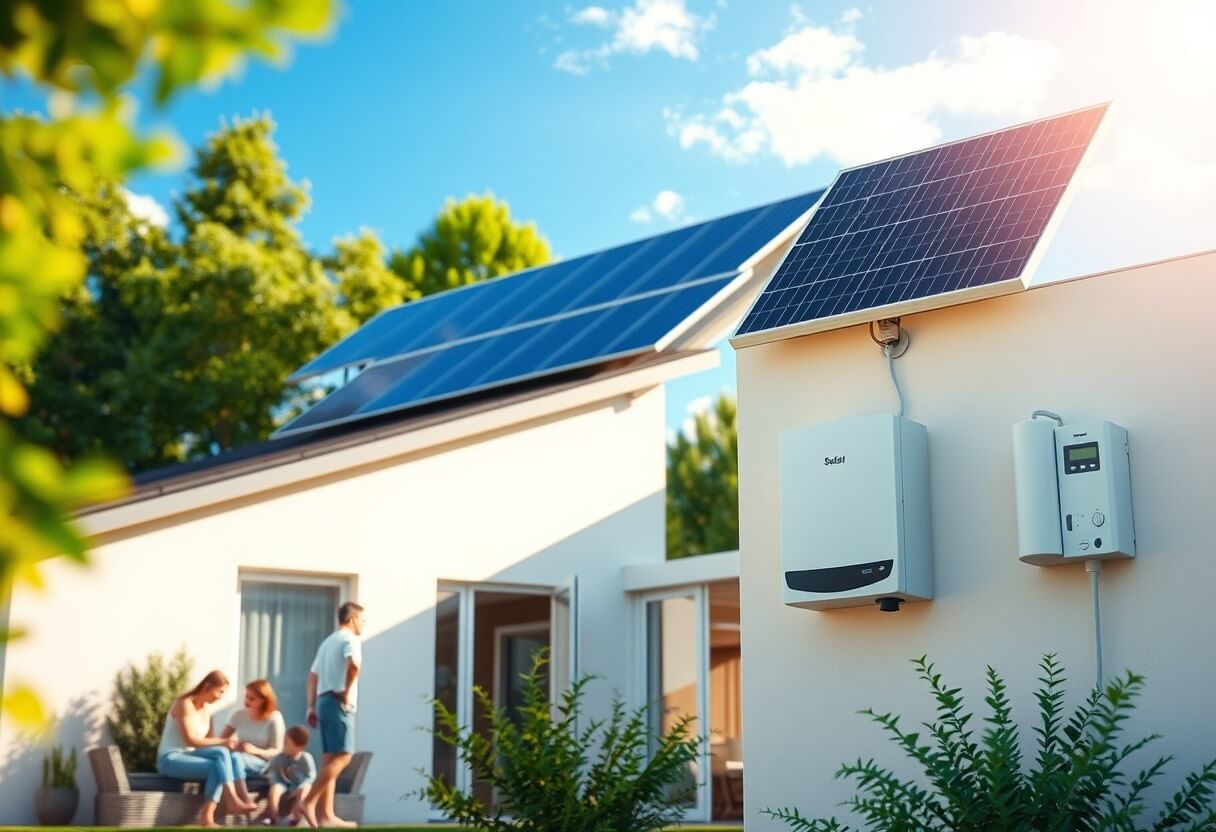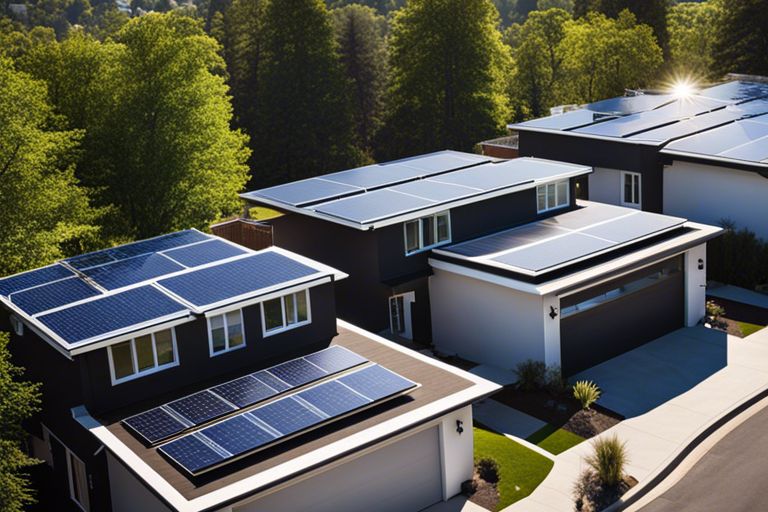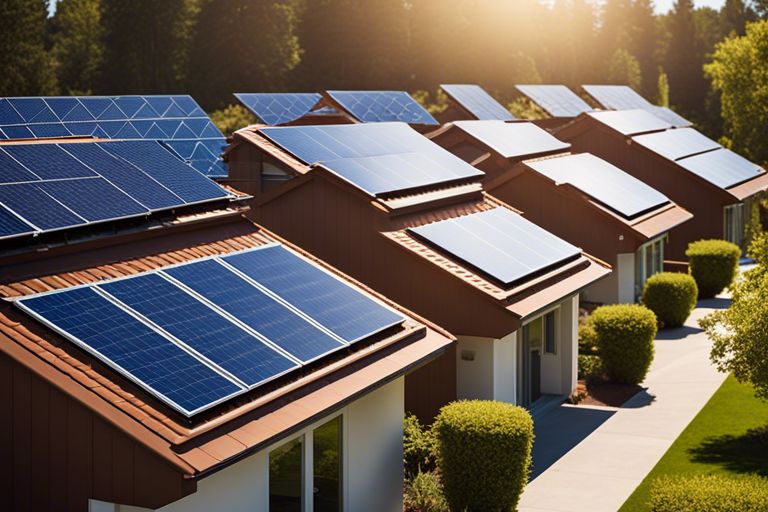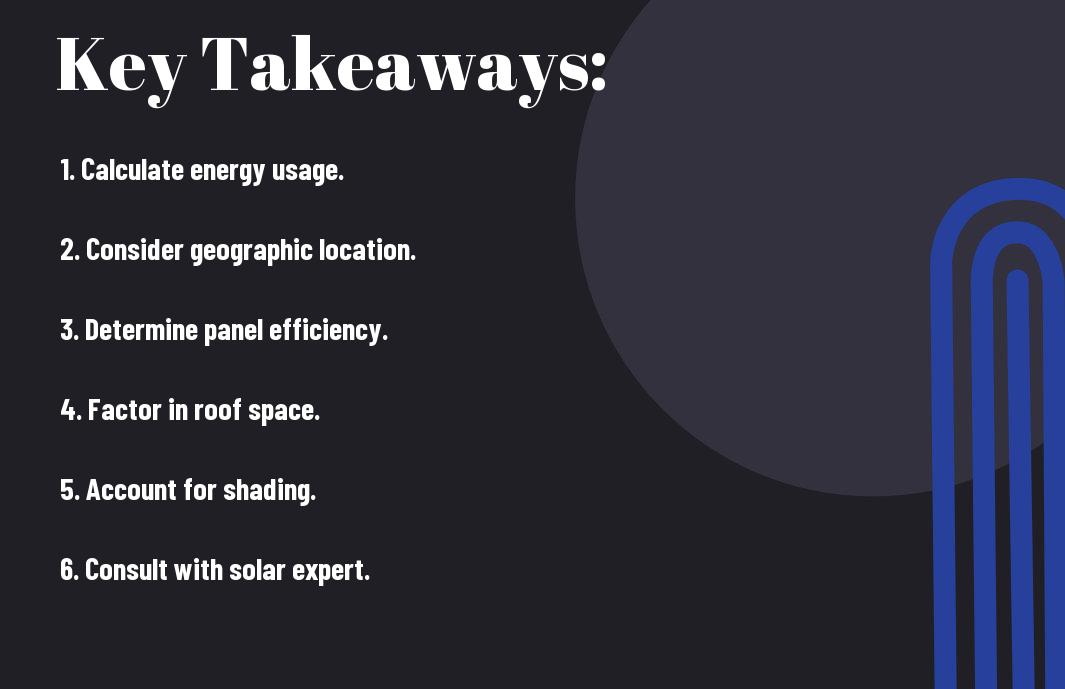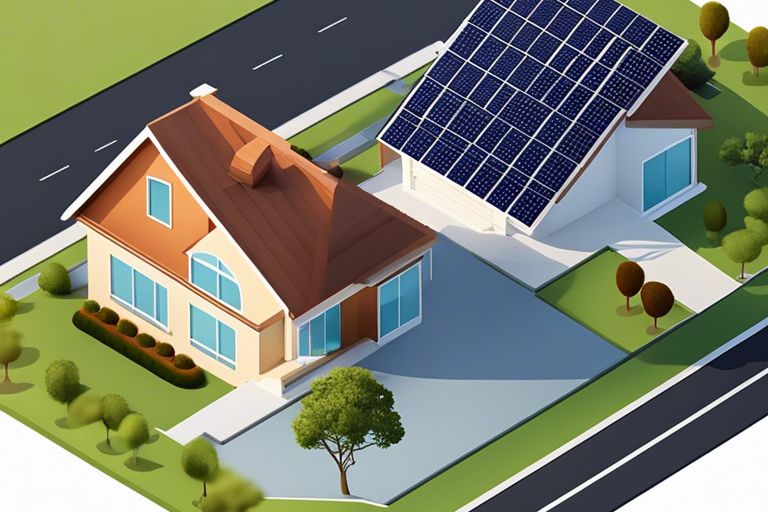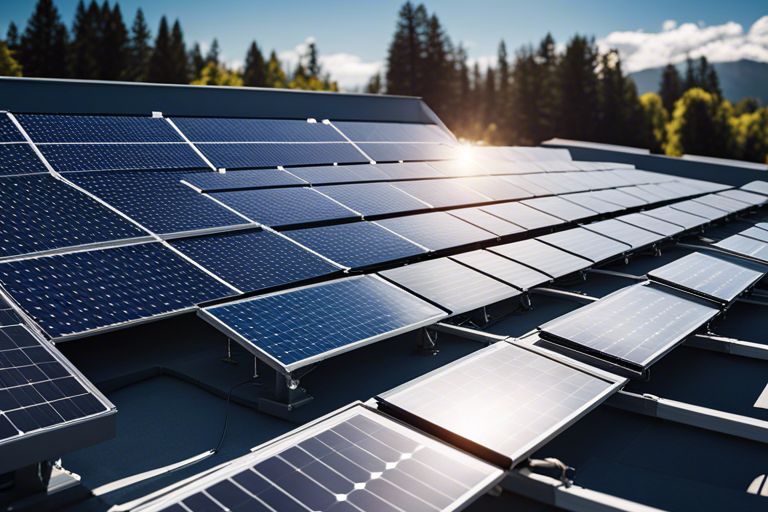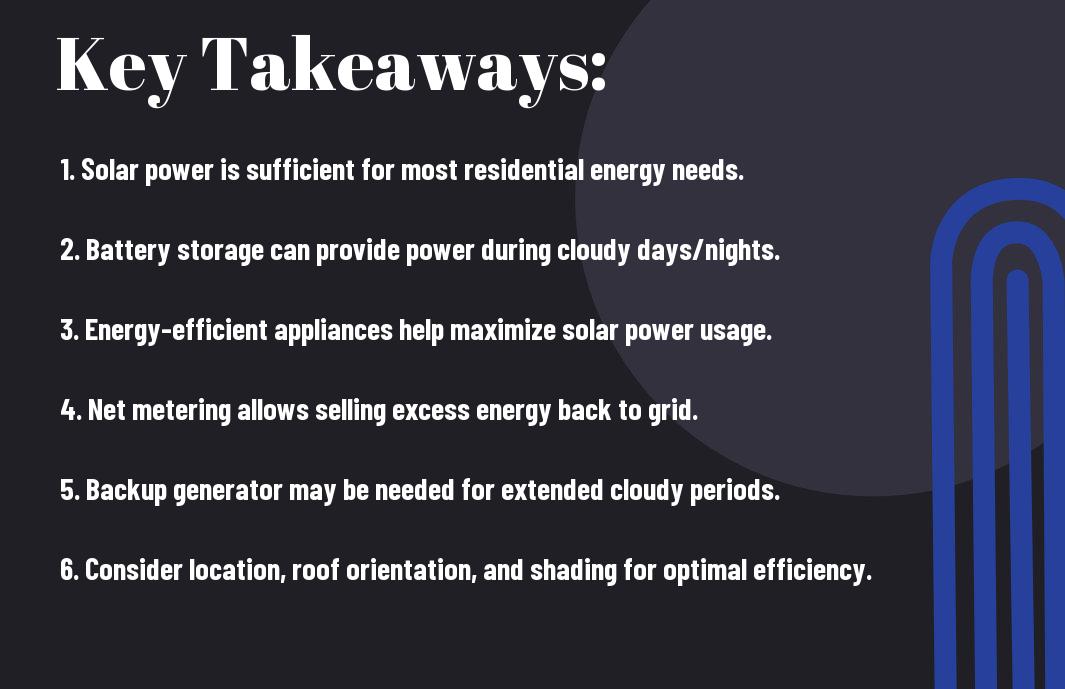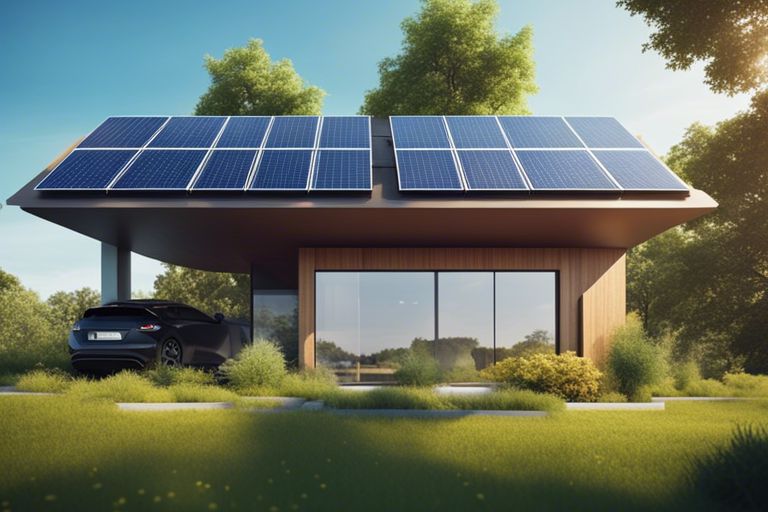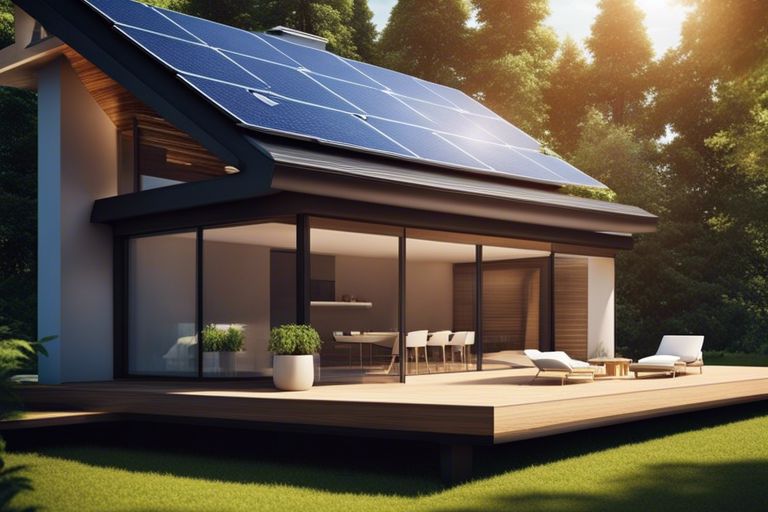Solar inverters play a crucial role in converting the direct current (DC) generated by your solar panels into usable alternating current (AC) for your home’s electrical system. Understanding the benefits and functionality of a solar inverter can help you make an informed decision about installing solar energy solutions in your home. With the right inverter, you can maximize energy efficiency, reduce electricity bills, and support sustainable living. In this post, we will explore whether a solar inverter is a worthwhile investment for your household energy needs.
Key Takeaways:
- Energy Efficiency: A solar inverter optimizes the conversion of sunlight into usable electricity, improving overall energy efficiency in the home.
- Cost Savings: By using a solar inverter, homeowners can significantly reduce their electricity bills and save money over time through renewable solar energy.
- System Monitoring: Many solar inverters come with monitoring features that allow users to track energy production and performance, ensuring optimal functionality.
- Grid Independence: A solar inverter provides homeowners with the potential for energy independence by facilitating the use of solar power, reducing reliance on the electrical grid.
- Environmental Impact: Utilizing a solar inverter contributes to a reduction in carbon footprint, promoting a more sustainable and eco-friendly lifestyle.
Understanding Solar Inverters
While considering solar energy for your home, it’s crucial to understand the role that solar inverters play in the system. These devices are vital components that convert the direct current (DC) electricity generated by solar panels into alternating current (AC) electricity, which is what your home appliances typically use. Thus, a solar inverter enables you to utilize the energy harnessed from the sun effectively, making it a pivotal element of any solar power system.
Definition of a Solar Inverter
To put it simply, a solar inverter is an electronic device that transforms the electrical output from solar panels, which is often in the form of DC, into AC. This conversion is necessary as most household appliances require AC for operation. Additionally, solar inverters ensure that the electricity produced by your solar panels synchronizes with the grid, or powers your home directly, depending on your setup.
To further understand its importance, you need to realize that the efficiency of a solar power system not only depends on the solar panels themselves but also significantly on the quality and type of inverter utilized. An efficient inverter will optimize energy usage from your solar panels, maximizing your energy savings and reducing reliance on the electric grid.
Types of Solar Inverters
On the market today, there are several types of solar inverters to consider, each with unique features and benefits. Understanding these types will help you decide on the most suitable option for your home solar power system. The primary types of solar inverters include string inverters, microinverters, and power optimizers, among others. Each type has its advantages and fits different scenarios based on your energy demands, the layout of your rooftop, and budget considerations.
| Type of Solar Inverter | Key Features |
|---|---|
| String Inverters | Cost-effective, easier installation, ideal for simple rooftops. |
| Microinverters | Optimized energy conversion for each panel, excellent for shaded or complex rooftops. |
| Power Optimizers | Combines advantages of string and microinverters, enhances overall panel efficiency. |
| Hybrid Inverters | Supports battery storage, versatile for future energy needs. |
| Grid-Tied Inverters | Efficient integration with grid systems, allows for net metering. |
Solar inverters are a crucial element of your solar power setup, affecting how well your system performs and your overall energy savings. Understanding the differences among them allows you to make informed decisions based on your home’s specific energy demands and cost considerations. Here are some key points to remember:
- String inverters are typically less expensive and easier to install, making them popular for standard residential setups.
- Microinverters are ideal for homes with complex rooftop layouts or shaded areas, as they optimize performance on a panel-by-panel basis.
- Power optimizers work well with string inverters, improving energy harvest from each solar panel.
- Hybrid inverters offer flexibility for future integration with energy storage systems.
- Grid-tied inverters facilitate easy connection to the electrical grid and enable net metering for earning credits on excess energy produced.
Recognizing these types and their features is vital for selecting the right solar inverter for your home’s unique energy needs.
Benefits of Using Solar Inverters at Home
Keep in mind that the choice to install solar inverters in your home can significantly enhance your energy efficiency and provide many long-term benefits. Understanding these advantages will help you make an informed decision about solar energy adoption. Solar inverters play a crucial role in converting the direct current (DC) generated by your solar panels into the alternating current (AC) that your home appliances use, making energy conversion one of their core functions.
Efficient Energy Conversion
For homeowners, efficient energy conversion is vital because it directly affects how much of the solar energy produced can be utilized. A good solar inverter maximizes the energy harvested from the sun and minimizes energy loss during the conversion process. This efficiency ensures that you get the most out of your investment in solar technology, making it a favorable choice for enhancing your overall energy usage.
Moreover, higher conversion efficiency translates to lower electricity bills, allowing you to save money over time. The latest models of solar inverters are designed to operate at peak performance, even in varying weather conditions, ensuring that you are continuously benefiting from solar energy, regardless of external factors.
Increased Energy Production
Energy production in a solar system is heavily reliant on the inverter’s capabilities. A high-quality solar inverter can enhance the overall energy output of your solar panel system by optimizing the performance of each panel. With advanced features such as Maximum Power Point Tracking (MPPT), these inverters adapt to changing sunlight conditions to extract optimal energy levels throughout the day.
With this technology, your system can take advantage of the maximum potential of sunlight at different times, increasing the total amount of electricity produced. As a result, you’ll enjoy more energy independence and the ability to power your home efficiently. You can check your energy production regularly and even sell excess power back to the grid, potentially creating a new income stream.
Plus, since solar inverters help manage energy output effectively, you’ll find that during peak sunlight hours, your energy production could potentially exceed your household needs, allowing you to redirect that energy either for storage or credit towards future electricity bills.
Grid Independence and Energy Storage
Production of solar energy not only allows you to harness power from the sun but also grants you increased independence from the traditional energy grid. By investing in a solar inverter and a compatible energy storage system, you can store excess energy generated during the day for use at night or during power outages. This aspect of grid independence makes your home not just energy-efficient, but also resilient to fluctuations in energy prices.
Energy independence leads to a more sustainable lifestyle. Not only will you be less affected by rising electricity rates, but you’ll also have greater control over your energy consumption habits. This control allows for a comprehensive approach to energy savings, which is especially valuable in areas where power outages are common.
Monitoring and Maintenance Features
Solar technology has evolved to integrate advanced monitoring and maintenance features, making it easier for you to keep track of your system’s performance. With many modern solar inverters, you can access real-time data about energy production, consumption levels, and overall system efficiency right from your smartphone or computer. This transparency enables you to take proactive steps in maintaining the health of your solar system.
Routine maintenance is necessary for ensuring the longevity of your investment. With built-in alerts and notifications, you can be informed immediately if there are any issues, allowing you to address them promptly and prevent more significant problems down the line. This hands-on approach not only enhances your energy management but also gives you peace of mind regarding your solar investment.
Increased awareness of how your solar energy system operates will empower you to maximize energy savings, adjust your consumption patterns, and ultimately enjoy the full array of benefits that solar inverters provide for your home.
Factors to Consider When Choosing a Solar Inverter
Many homeowners are keen on investing in solar energy solutions and a solar inverter is a crucial component of the system. When identifying a solar inverter, there are several important factors to take into account. These can impact the performance, durability, and, ultimately, the efficiency of your solar energy system. Here are some key considerations:
- System Compatibility
- Warranty and Lifespan
- Installation Requirements
- Cost and Financial Incentives
The long-term success of your solar energy system hinges on how well the inverter aligns with your current setup. This makes What are the pros and cons of getting an inverter for your … an necessary aspect of your decision-making process.
System Compatibility
The inverter you choose must be compatible with your solar panel system. This includes ensuring that the inverter can handle the output voltage of your solar panels. If you have a unique type of solar panel, it’s necessary to verify that the inverter can manage the varying energies efficiently. Compatibility not only ensures optimal performance, but it also affects the safety and longevity of your overall solar system.
Additionally, consider the type of solar inverter—string inverters, microinverters, and power optimizers. Each type has its strengths and weaknesses, and their compatibility will depend on your specific setup. Understanding these differences will help you make a more informed choice that aligns with your energy needs.
Warranty and Lifespan
Warranty is a critical factor when selecting a solar inverter. Generally, inverters come with limited warranties that can last between 5 to 15 years, and it’s vital to choose one that offers adequate coverage. A longer warranty period can often indicate better build quality and reliability. Therefore, investigating manufacturers’ reputations and their warranty offerings can save you future costs and headaches.
Moreover, consider the expected lifespan of the inverter itself. Most have a functional lifespan between 5 to 25 years, depending on the type and brand. Choosing an inverter from a reputable manufacturer with a strong warranty can maximize your investment in solar technology.
Factors such as the quality of components used, the technology involved, and troubleshooting support can also influence the durability of your inverter. Investing in a high-quality inverter can ensure that it works effectively for years to come.
Installation Requirements
Warranty should also cover the installation process, as improper installation can lead to numerous issues down the line. You’ll want to understand the unique installation requirements of the solar inverter you choose. Different models and brands may have specific guidelines on installation that must be adhered to for optimal performance.
Moreover, the installation might require whether it’s a complex setup or not and could determine if you need to hire a professional electrician or can do it yourself. This added cost needs to be part of your budget when selecting your inverter.
This consideration not only factors into the immediate costs but also affects maintenance and repairs in the future. You want an inverter that doesn’t just fit your current needs but can also adapt to any potential upgrades without incurring excessive installation costs again.
Cost and Financial Incentives
Compatibility with your budget is necessary when selecting an inverter. Inverter prices can vary widely, and it’s crucial to weigh these costs against the financial incentives available in your area, such as tax credits, rebates, and financing options. Understanding your budget will help you find a good quality inverter without overspending.
Additionally, keep an eye on available financial incentives that may offset some initial costs. Many states and local governments offer programs designed to make solar energy systems more affordable, so researching these incentives can provide substantial savings.
Inverter options often come with different prices, so take the time to shop around and consult professionals for advice tailored to your specific situation, which could make your investment more worthwhile.
Common Misconceptions about Solar Inverters
Once again, as more homeowners consider solar energy, a few common misconceptions surrounding solar inverters continue to persist. These misconceptions might hold you back from making the switch, so it’s crucial to clarify them for your better understanding. One significant misconception is the assumed complexity of operating a solar inverter. Many people think that solar inverters are complicated devices that require an engineering degree to manage. However, this isn’t the case at all. Modern solar inverters are designed with user-friendliness in mind. They typically come with intuitive interfaces and clear instructions that make it easy for anyone to operate. If you’re interested in exploring the Top 10 Benefits of Installing a Solar Inverter for your Home, you’ll see how simple managing your energy usage can truly be.
Misconception of Complexity
About the complexity of solar inverters, it is vital to recognize that they are equipped with automatic features that minimize user intervention. For instance, many models have alerts or notifications to inform you about their performance or when maintenance is due. This means you can easily keep an eye on your system without constantly being engaged in its operation. Furthermore, most modern solar inverters are equipped with monitoring apps that enable you to track energy production and usage directly from your smartphone or computer, adding another layer of convenience.
Misconception of High Maintenance
To address the misconception of high maintenance associated with solar inverters, it’s important to clarify that these devices are built to be low-maintenance. While it’s true that like any equipment, your solar inverter will require some upkeep, it typically doesn’t demand a significant time or financial investment. Most systems only need a visual inspection every few months, with occasional cleaning of dust or debris to ensure optimal performance.
Solar inverters come with warranties that usually span 5 to 10 years, assuring you of their longevity. After that, they may need replacement or servicing, but this is a standard practice for many home appliances. Additionally, some manufacturers offer maintenance packages that can help manage costs and ensure that your system is always running efficiently.
Misconception of Inefficiency
Any concerns about the inefficiency of solar inverters stem from older technology or insufficient understanding of how modern units operate. Today’s inverter technology has significantly advanced, with many models boasting close to 98% efficiency in converting solar energy into usable electricity. This means that minimal energy is lost during the conversion process, making your solar energy system highly effective and reliable.
Inverters are engineered to maximize energy output, and you may even have the option to install more advanced models that employ maximum power point tracking (MPPT) technology. This feature optimizes the amount of energy your solar panels can harvest, especially under varying weather conditions.
Misconception of Limited Applicability
Maintenance of solar inverters is often seen as a barrier for potential users, with many thinking these systems are only suitable for specific types of homes or locations. In reality, solar inverters can be utilized in a variety of settings, including residential homes, commercial properties, and even remote locations without grid access. Their versatility makes them a practical choice for various energy needs.
It’s crucial to understand that solar inverters are adaptable, designed to work with different types of solar panel systems, and can even be integrated into existing electrical setups. This means that whether you have a small home or a larger estate, there’s a solar inverter solution available to meet your energy requirements.
Comparison of Leading Solar Inverter Brands
Despite the multitude of options available in the solar inverter market, assessing which brands stand out can be crucial to making an informed choice for your home. Several key factors, such as brand reputation, performance, customer satisfaction, and price, play a significant role in determining which solar inverter will best suit your specific needs. In this comparison, we focus on some of the leading solar inverter brands in the industry to help guide you to the right decision.
Brand Overview
| Brand Name | Overview |
|---|---|
| SMA Solar Technology | SMA is a German company known for high-quality solar inverters with a strong global presence and a long history of innovation. |
| SolarEdge | SolarEdge specializes in power optimizers and inverters, offering advanced monitoring and high efficiency for residential and commercial systems. |
| Fronius | An Austrian manufacturer, Fronius is recognized for its robust inverters that balance performance with user-friendly features. |
| Enphase Energy | Enphase focuses on microinverter technology, providing increased installation flexibility and system monitoring. |
Brand Overview
For you, understanding the background of the brands can help you determine their credibility and what reputation they hold in the market. Higher-quality brands generally offer better reliability, efficiency, and customer service, ensuring you make a worthwhile investment in your home’s energy infrastructure.
Moreover, each brand has its unique strengths and specialties, so it is important for you to consider what features matter most for your particular setup, whether that’s ease of installation, advanced technology, or cost-effectiveness.
Performance Metrics
Any time you assess solar inverters, performance metrics are important indicators of efficiency, reliability, and longevity. Key metrics to consider include the inverter’s efficiency rating (often around 97-99%), operating temperature range, and warranty offerings. These factors will directly impact how well an inverter performs in your specific environment, which can be especially important depending on your geographic location and climate.
In addition, monitoring features can enhance your experience by providing real-time data on your solar system’s performance. Brands that offer comprehensive performance stats can help you optimize your energy consumption and ensure you are getting the most out of your solar investment.
Comparison of these performance metrics among leading brands allows you to benchmark which inverter will provide you with the best efficiency and lifespan for your solar setup.
Customer Satisfaction and Reviews
Comparison of customer satisfaction and reviews can greatly inform your decision. Reviews from real users often highlight experiences related to performance reliability, customer service, and if the product met their expectations. For instance, some brands might have great performance metrics but poor customer service, which can lead to frustration when issues arise.
Be sure to sift through online reviews and testimonials available on various platforms to get a comprehensive view of the experiences other customers have had with their chosen solar inverters. It’s also valuable to consider the brand’s response to negative feedback, as this reflects their commitment to customer satisfaction.
This deeper probe customer reviews can offer you insights into potential problems and benefits that are not immediately apparent through product specifications alone.
Price Comparisons
Brands often vary significantly in terms of pricing, which can ultimately affect your decision. To help gauge your options, consider the following price ranges for leading brands:
Price Comparison
| Brand Name | Approximate Price Range |
|---|---|
| SMA Solar Technology | $1,500 – $3,000 |
| SolarEdge | $1,200 – $2,800 |
| Fronius | $1,500 – $3,000 |
| Enphase Energy | $2,000 – $2,500 per unit |
Brands such as SolarEdge often provide more affordable options depending on your system needs, while others like SMA Solar Technology may command a higher price due to additional features and proven reliability. When calculating the total cost, don’t forget to factor in installation expenses and any potential long-term savings from energy efficiency.
Brand Price Comparison
| Brand Name | Price Notes |
|---|---|
| SMA Solar Technology | Offers robust warranties that can factor into long-term value. |
| SolarEdge | Known for high performance at a competitive price scale. |
| Fronius | Combines innovation with moderate pricing, often regarded as a solid investment. |
| Enphase Energy | While priced higher per unit, the added benefits of microinverter technology can enhance value. |
It’s important for you to weigh these price comparisons against the performance and reliability metrics to ensure you choose a brand that aligns with both your budget and your energy needs. Your overall satisfaction with your solar inverter will ultimately depend on how well it meets both your performance expectations and financial criteria.
Maintenance and Troubleshooting Solar Inverters
For any homeowner considering the installation of a solar inverter, understanding the importance of regular maintenance and troubleshooting is imperative for the longevity and efficiency of your solar system. Regular maintenance practices can prevent minor issues from escalating and ensure that your system operates smoothly. Monitoring the performance of your inverter, cleaning it periodically to remove dust and debris, and checking for loose connections are all fundamental steps you can take. Additionally, reviewing your inverter’s display readings regularly will help you gauge its performance and catch any irregularities early on.
Regular Maintenance Practices
For optimal performance, you should follow specific maintenance practices at least twice a year. This includes inspecting the surrounding area for any obstructions that might block sunlight, ensuring that wires and cables are intact, and verifying that the inverter’s cooling fan is functioning properly. A thorough inspection of the components can save you the cost of repairs down the line due to undetected issues. Additionally, keeping an eye on the manufacturer’s guidelines for maintenance can ensure that you are adhering to best practices specific to your model.
Common Issues and Solutions
Troubleshooting common issues with solar inverters is part of maintaining your solar power system. One of the most frequent problems homeowners face is an inverter shutdown, often due to overheating or system faults. In such instances, ensure that the inverter is adequately ventilated and not exposed to excessive heat. Check the error codes displayed on the inverter, as each code corresponds to a specific issue that you can research or consult the manual for clarification. Doing so can often help pinpoint whether the issue is something you can resolve yourself or if professional assistance is needed.
Issues like voltage fluctuations and unexpected drops in performance may also arise. Regularly inspect your solar panels for dirt and debris, as a dirty panel can lead to poor energy production. Connecting wiring can also become compromised over time, leading to power loss. If you experience consistent performance issues despite your best efforts, it might indicate a deeper electrical or mechanical fault within the system.
When to Call a Professional
Solutions to common inverter problems may sometimes require you to consult with a professional. If you notice persistent issues or recurring error codes that you cannot resolve, seeking guidance from a certified technician is advisable. They possess the expertise to diagnose complex problems that may not be evident through visual inspections. As a general rule, if your inverter requires repair or replacement of parts, or if you have doubts about your troubleshooting efforts, don’t hesitate to reach out to a professional.
Solutions that involve working with electrical components can be hazardous, especially if you lack experience. For your safety and optimal function of your solar system, professionally trained technicians can handle repairs and complex issues more effectively. They can also guide you on best practices for ongoing maintenance.
Lifespan and Replacement Guidelines
Common knowledge suggests that the lifespan of a solar inverter generally ranges between 5 to 15 years, depending on the type of inverter and your usage patterns. As technology progresses, it is imperative to keep abreast of advancements that may offer enhanced efficiency and features. It may be prudent to replace your inverter if it shows signs of decreasing performance or has reached the end of its expected lifespan. Keeping track of your inverter’s performance and maintenance history can inform you when it’s time to consider an upgrade.
An inverter replacement is not just about maintaining performance; it can also enhance the efficiency of your entire solar power system. Newer models may come equipped with improved technology that allows for better energy conversion and storage. A well-timed replacement can ensure that your investment in solar energy continues to pay off in the long run.
Plus, routine evaluations of your solar inverter and system can help you anticipate when a replacement may soon be necessary. This proactive approach enables you to budget for the replacement ahead of time, ensuring that you won’t face unexpected costs down the line. By staying informed and attentive to your system’s needs, you can maximize your solar energy investment effectively.
Summing up
Now that you’ve considered the various factors surrounding the use of a solar inverter for your home, it’s imperative to understand its benefits. A solar inverter plays a crucial role in converting the DC electricity generated by your solar panels into AC electricity, which is what your household appliances use. By investing in a quality solar inverter, you can significantly enhance the efficiency of your solar energy system, leading to reduced electricity bills and a lower carbon footprint. Moreover, with advancements in technology, modern inverters often come equipped with features such as monitoring capabilities, which allow you to keep track of your system’s performance and make informed decisions about energy consumption.
Ultimately, determining whether a solar inverter is good for your home hinges on your specific energy needs, the climate of your area, and your commitment to sustainability. If you are looking to maximize the benefits of your solar energy system while contributing to a greener future, opting for a high-quality solar inverter is a sound choice. By integrating this technology into your home, you not only increase your energy independence but also potentially increase the value of your property. It’s a step towards smarter living and a more sustainable lifestyle that can provide lasting benefits for years to come.
FAQ
Q: What is a solar inverter and why is it important for a home solar system?
A: A solar inverter is a critical component of a home solar system. It converts the direct current (DC) generated by solar panels into alternating current (AC), which is the type of electricity used in homes. Without an inverter, the electricity produced by solar panels cannot be used to power household appliances or fed back into the grid. In short, the inverter is important for harnessing solar energy effectively and ensuring it is usable in a residential setting.
Q: What are the benefits of using a solar inverter for my home?
A: Using a solar inverter provides several benefits for homeowners, including: 1) Efficiency in energy conversion, allowing for maximized use of solar energy; 2) Reduction in electricity bills, as excess energy can be sold back to the grid or used to offset your energy consumption; 3) Environmental impact, as solar energy is a clean and renewable resource; and 4) Monitoring capabilities, enabling homeowners to track energy production and consumption in real time through app integrations.
Q: Are there different types of solar inverters, and which one is best for home use?
A: Yes, there are three main types of solar inverters: string inverters, microinverters, and power optimizers. String inverters are the most common and typically work well for installations with panels installed at similar angles and orientations. Microinverters, however, are ideal if the roof has shading issues or panels have different orientations, as they allow each panel to operate independently. Power optimizers combine features of both string inverters and microinverters, enhancing performance for partially shaded panels. The best choice depends on the specific needs and configuration of your home solar system.
Q: How long do solar inverters last, and what maintenance do they require?
A: Solar inverters typically last about 5 to 15 years, depending on the type and brand. With regular maintenance, including periodic inspections and cleaning to remove debris or dust, they can operate efficiently throughout their lifespan. Many manufacturers offer warranties, so it may be beneficial to choose an inverter with a longer warranty period, as this can provide peace of mind for homeowners in case of any defects or issues over time.
Q: Can a solar inverter be integrated with battery storage systems for home use?
A: Yes, most modern solar inverters can be integrated with battery storage systems. This allows homeowners to store excess energy generated during the day for use at night or during power outages. Battery integration enhances energy independence by reducing reliance on grid electricity and provides additional security against fluctuating energy prices. When selecting a solar inverter for battery integration, make sure it is specifically designed to work with your chosen battery system for optimal performance.

